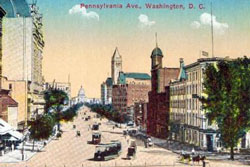
Washington Light Infantry Armory (1907)
15th and Pennsylvania Avenue, N.W.
Built: Unknown, before 1891
Razed: c. 1923
Approximate capacity: 1,000
Built in 1884 as the lower level to what became known as Albaugh's Grand Opera House, the armory hosted various public exhibitions and sporting events. In the image to the right, a contemporary postcard of Pennsylvania Avenue would place the armory as the white building in the right hand side of the picture. The building was razed to make way for the construction of the Department of Commerce Building in the mid 1920's.
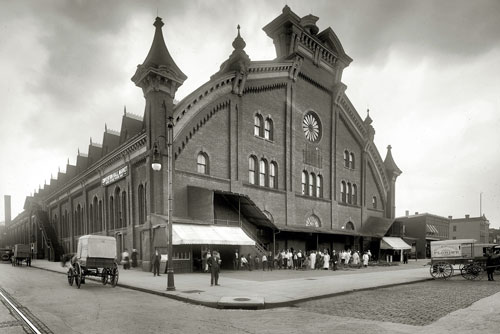
Convention Hall (1907-08)
5th and K Streets, N.W.Built: 1874
Razed: 1946
Capacity: 5,000
In 1907, games moved to Convention Hall, the upper floor of the Northern Liberty Market complex, a building spanning 326 feet long and 124 feet wide across a two block section east of Mt. Vernon Square. It served as a site for numerous civic events until a fire destroyed the building in 1946. The rebuilt facility became the National Historical Wax Museum in 1967. The property was abandoned in the 1980's and is now the site for City Vista, an upscale condominium property.
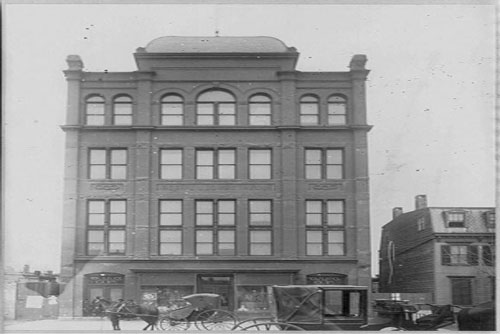
Odd Fellows Hall (1908-11)
7th and D Streets, N.W.
Built: 1880
Razed: 1921
Capacity unknown
After the money lost on renting Convention Hall, games were moved to the downtown lodge of the Odd Fellows, a fraternal organization founded in Baltimore. The building was reconstructed in 1921 and still stands today, just north of the Archives Metro station.
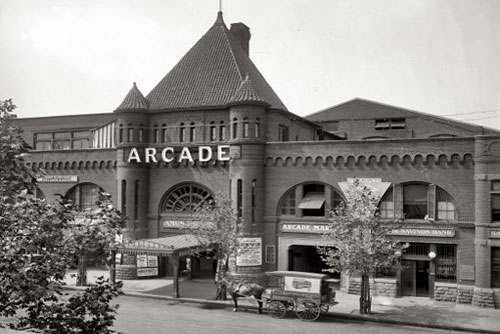
Arcade (1911-14, 1927-28)
3134 14th St., N.W.
Built: 1892
Razed: 1948
Approximate capacity: 1,000-2,600
Originally built as a transit car barn, the Arcade was repurposed as a sports and entertainment facility in 1906, featuring a movie theater, skating rink, billiards room, bowling alley, and sports auditorium. The building was razed in 1948. It is currently the site of a neighborhood shopping center.
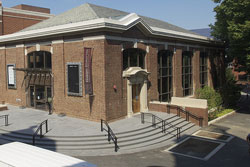
Ryan Gymnasium (1914-27)
37th and O Streets, N.W.
Built: 1906
Capacity: Standing only (approx. 200)
Ryan Gymnasium was obsolete from the start as a spectator facility, but served as the home for the program for 45 years. Georgetown's athletic department vacated the facility in 1951 upon the completion of McDonough Gym. The building was later reconfigured to house the treasurer's office and later housed an on-campus branch of the Riggs National Bank. In 2005, it reopened as the Davis Center for Fine Arts following a $21 million renovation effort.
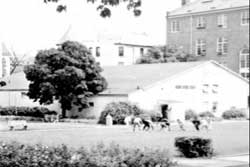
GWU Gymnasium (1928)
20th and H Street., N.W.
Built: 1925
Razed: 1975
Capacity: Unknown
The first three home games of the 1928-29 season were played at George Washington University. Known to GW students as the "Tin Tabernacle", the facility proved insufficient to host college games and Georgetown's stay there was brief.
The building was razed in 1975 following the completion of the Charles E. Smith Center.
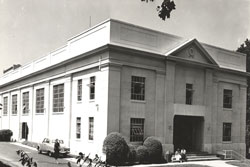
Clendenen Gymnasium (1928-29)
4400 Massachusetts Ave., N.W.
Built: 1927
Razed: 1984
Capacity: 800
During the 1928-29 season, Georgetown secured the use of American University's new gymnasium. College games soon outgrew the building, as the Eagles played off campus for almost thirty years before the completion of Bender Arena in 1985, built on the same site.
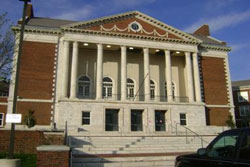
Tech Gymnasium (1930-40,1942-43)
2nd and T Streets, N.E.
Built: 1929
Capacity: 1,800
In 1929, the a new campus was created for the students of McKinley Vocational and Washington Tech high schools, later known as McKinley Tech. The gym became a favorite for a number of area schools, including Georgetown. Georgetown played at Tech throughout the 1930's, and during the 1942-43 wartime season. McKinley Tech was closed in 1997 and reopened in 2004.
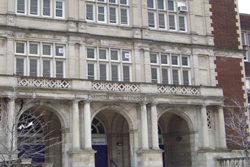
Central Gymnasium (1931)
13th and Clifton Street, N.W.
Built: Unknown
Razed: Mid-1950's (?)
Capacity unknown
For one game in the 1931-32 season, Georgetown played a home game at the gymnasium of Central High School.
Following the 1950 Supreme Court decision that desegregated the Washington public school system, the all-white Central was closed and replaced by the desegregated Cardozo High School, which moved from 8th and Rhode Island streets, N.W. following the decision.
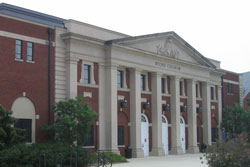
Ritchie Coliseum (1937)
Route 1, College Park, MD
Built: 1935
Capacity: 1,700
For one game in the 1937-38 season, Georgetown played a home game at the gymnasium of the University of Maryland. Ritchie Coliseum was the home of the Terrapin basketball team from 1931 through 1956, when Cole Field House opened. The facility currently serves as the home of Maryland's volleyball and wrestling teams.
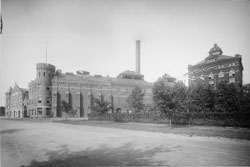
Riverside Stadium (1940-42)
23rd and E Streets, N.W.
Built: 1938
Razed: Early 1950's
Capacity: 7,000
Washington's first sports complex was constructed adjacent to the Heurich Brewery in 1938. The Heurich Brewery was sold in 1956 to make way for the Kennedy Center. The adjacent Riverside area was redeveloped into the Watergate apartment complex.
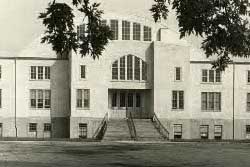
Brookland Gymnasium (1945-46)
620 Michigan Avenue, N.E.
Built: 1919
Capacity: 1,500
The Hoyas' 1945-46 season was played on the campus of Catholic University, where Brookland Gymnasium sat adjacent to the stadium of the same name. Four home games were also played there in 1947 due to conflicts at Uline Arena. The gym was renovated for offices and is now known as the Crough Center.

Uline Arena (1946-47,1949-51)
aka Washington Coliseum
2nd and M Streets, N.E.
Built: 1940
Capacity: 7,000
Washington's first pro sports arena, Uline Arena hosted social and sporting events in Washington for nearly a generation, including two stints as the Hoyas' home court. Following the death in 1958 of its founder, Miguel (Mike) Uline, the building was renamed the Washington Coliseum, where it was the first arena in the U.S. to host the Beatles in February, 1964. The building twice escaped demolition in the early 2000's and is now the site of an REI department store.
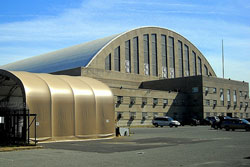
D.C. Armory (1947-49)
aka Starplex
23rd and East Capitol Streets, S.E.
Built: 1947
Capacity: 10,000
Georgetown played two seasons at the armory, located next to what is now RFK Stadium. Rents were high, so colleges migrated back to Uline Arena or the gymnasium at Ft. Myer, VA, which hosted home games for George Washington and American as late as 1985. In 1979, Georgetown and Maryland met as a neutral game at the Armory, but the teams never returned following the cessation of the series in 1980.
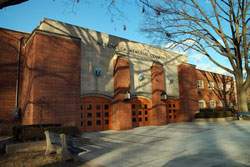
McDonough Gymnasium (1951-81)
37th and O Streets, N.W.
Built: 1951
Capacity: 2,200 to 4,200
As early as 1927, plans were announced to build a 7,000 seat replica of the Palestra on the land just outside Healy Gates. 20 years later,a $1.25 million campaign built McDonough Gym on campus. Ticket interest in the Hoyas following the 1980-81 season moved home games to Capital Centre. Various games have been played there in the interim; the entire 2020-21 home season was played there without fans due to COVID-19 restrictions.
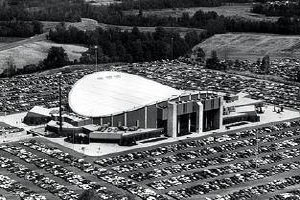
Capital Centre (1981-97)
aka US Air Arena
1 Harry S. Truman Dr., Landover, MD
Built: 1974
Razed: 2002
Capacity: 19,035
Capital Centre was the showplace of the suburban arena building boom of the 1970's. The first arena to have a video screen, the arena was the center of Washington's sports landscape for over 20 years. Georgetown first played there in the mid-1970's with a series of games against Maryland, and moved home games there in 1981. Renamed US Air Arena in 1994, the Hoyas played its last game in Landover in November 1997, a week before the opening of MCI Center. With no remaining tenants, the building was razed in 2002 to make room for a shopping center.
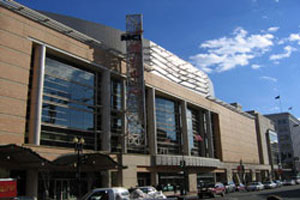
Capital One Arena (1997-)
aka MCI Center, Verizon Center
7th and G Streets, N.W.
Built: 1997
Capacity: 20,500
With the move of Washington's pro teams to a new downtown arena, Georgetown followed suit in 1997. A state of the art facility, it has hosted most Georgetown home games since. The facility, originally called MCI Center, was renamed in 2006 following MCI's acquisition by Verizon Corp and in 2017 with rights purchased by Capital One Financial Corp.